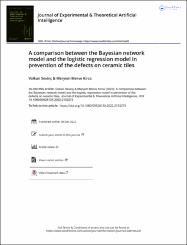A comparison between the Bayesian network model and the logistic regression model in prevention of the defects on ceramic tiles
Citation
Volkan Sevinç & Meryem Merve Kırca (2022) A comparison between the Bayesian network model and the logistic regression model in prevention of the defects on ceramic tiles, Journal of Experimental & Theoretical Artificial Intelligence, DOI: 10.1080/0952813X.2022.2153273Abstract
One of the most important problems encountered in ceramic tile industry is defective product problem. Defective ceramics lead to loss of income and waste of resources in enterprises. However, it is generally unknown that which factors and production stages cause what kinds of defects. On the other hand, in the literature, the existing modelling studies usually consider the defects seen on industrial ceramics. The defect types of industrial ceramics and those of ceramic tiles are different. This article investigates the reasons behind the defect occurrences on ceramic tiles, along with a comparison between a logistic regression model and a Bayesian network model. The study shows that the Bayesian network model is more successful in estimating the defect types. The constructed Bayesian network model indicates that, in general, the high levels of the production band speed significantly increase the probabilities of all kinds of defects except the deformation defect. Additionally, the high densities of the glaze also increase the occurrence levels of the defects except the deformation defect. Similarly, the high levels of the engobe weight and the engobe density are also among the factors increasing the defect occurrences.


















